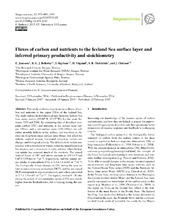| dc.contributor.author | Jeansson, Emil | |
| dc.contributor.author | Bellerby, Richard | |
| dc.contributor.author | Skjelvan, Ingunn | |
| dc.contributor.author | Frigstad, Helene | |
| dc.contributor.author | Ólafsdóttir, Sólveig R. | |
| dc.contributor.author | Ólafsson, Jón Hjaltalín | |
| dc.date.accessioned | 2018-08-22T13:48:09Z | |
| dc.date.available | 2018-08-22T13:48:09Z | |
| dc.date.issued | 2015-02-12 | |
| dc.Published | Jeansson E, Bellerby R, Skjelvan IS, Frigstad H, Ólafsdóttir, Ólafsson. Fluxes of carbon and nutrients to the Iceland Sea surface layer and inferred primary productivity and stoichiometry. Biogeosciences. 2015;12(3):875-885 | eng |
| dc.identifier.issn | 1726-4170 | en_US |
| dc.identifier.issn | 1726-4189 | en_US |
| dc.identifier.uri | https://hdl.handle.net/1956/18199 | |
| dc.description.abstract | This study evaluates long-term mean fluxes of carbon and nutrients to the upper 100 m of the Iceland Sea. The study utilises hydro-chemical data from the Iceland Sea time series station (68.00° N, 12.67° W), for the years between 1993 and 2006. By comparing data of dissolved inorganic carbon (DIC) and nutrients in the surface layer (upper 100 m), and a sub-surface layer (100–200 m), we calculate monthly deficits in the surface, and use these to deduce the long-term mean surface layer fluxes that affect the deficits: vertical mixing, horizontal advection, air–sea exchange, and biological activity. The deficits show a clear seasonality with a minimum in winter, when the mixed layer is at the deepest, and a maximum in early autumn, when biological uptake has removed much of the nutrients. The annual vertical fluxes of DIC and nitrate amounts to 2.9 ± 0.5 and 0.45 ± 0.09 mol m−2 yr−1, respectively, and the annual air–sea uptake of atmospheric CO2 is 4.4 ± 1.1 mol C m−2 yr−1. The biologically driven changes in DIC during the year relates to net community production (NCP), and the net annual NCP corresponds to export production, and is here calculated as 7.3 ± 1.0 mol C m−2 yr−1. The typical, median C : N ratio during the period of net community uptake is 9.0, and clearly higher than the Redfield ratio, but is varying during the season. | en_US |
| dc.language.iso | eng | eng |
| dc.publisher | Copernicus Publications | en_US |
| dc.rights | Attribution CC BY | eng |
| dc.rights.uri | http://creativecommons.org/licenses/by/4.0 | eng |
| dc.title | Fluxes of carbon and nutrients to the Iceland Sea surface layer and inferred primary productivity and stoichiometry | en_US |
| dc.type | Peer reviewed | |
| dc.type | Journal article | |
| dc.date.updated | 2018-07-02T14:29:33Z | |
| dc.description.version | publishedVersion | en_US |
| dc.rights.holder | Copyright 2015 The Author(s) | en_US |
| dc.identifier.doi | https://doi.org/10.5194/bg-12-875-2015 | |
| dc.identifier.cristin | 1221986 | |
| dc.source.journal | Biogeosciences | |
| dc.relation.project | EU: 264879 | |
| dc.relation.project | EU: 264933 | |
| dc.relation.project | EU: 265294 | |
| dc.subject.nsi | VDP::Matematikk og naturvitenskap: 400::Zoologiske og botaniske fag: 480::Marinbiologi: 497 | |
| dc.subject.nsi | VDP::Mathematics and natural scienses: 400::Zoology and botany: 480::Marine biology: 497 | |
| dc.subject.nsi | VDP::Matematikk og naturvitenskap: 400::Geofag: 450::Oseanografi: 452 | |
| dc.subject.nsi | VDP::Mathematics and natural scienses: 400::Geosciences: 450::Oceanography: 452 | |

